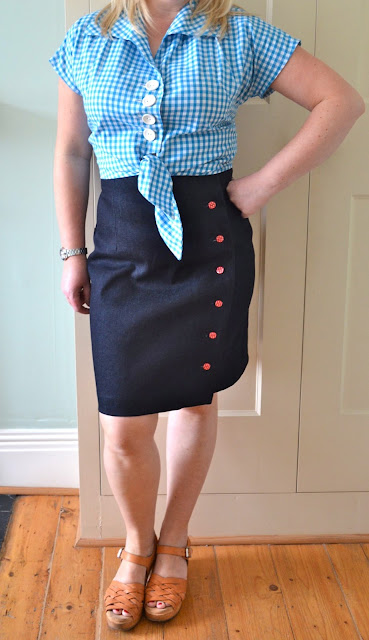This tutorial was first published in Issue 13 of Love Sewing magazine in April but annoyingly, a couple of the step-by-step photographs were printed in the wrong order. So I'm pleased to post the full tutorial here on the blog, with everything hopefully in the right place. I've tried to be as clear and thorough as I possibly can with the instructions, but as always, if there's anything that doesn't make sense, please do let me know. Have a lovely weekend. x
CHEQUERBOARD BABY BLANKET TUTORIAL
You will need:
1 metre plain cotton fabric
1 metre patterned cotton fabric*
1 metre fleece fabric
5 metres double fold bias binding (25mm/1inch wide)
*The adorable elephant fabric I used was from here
Seam allowance is ¼” throughout unless otherwise specified.
1. Cut your fabric into strips:
Six strips of patterned fabric each measuring 10cm x 100cm wide
Six strips of solid fabric each measuring 10cm x 100cm wide
2. Right sides facing, sew six strips together along the long edges, starting with a patterned strip at the top and alternating with the solid strips e.g.pattern/solid/pattern/solid/pattern/solid. If you’re using a directional print, make sure it’s all facing in the same direction!
3. Do exactly the same with the remaining six strips, except this time you need to start with a SOLID strip at the top.
Press seams to one side towards the patterned strips.
4. Mark across the top and bottom of each panel at 10cm intervals. The width of each panel is 100cms so it should be evenly divided into 10. Use a cutting mat or a long ruler to line up the marks to get a straight line.
Cut each panel vertically as marked. Repeat for the second panel.
You should end up with 20 vertical strips of fabric, each comprising six squares. 10 vertical strips should start with a patterned square at the top and 10 should start with a solid square at the top.
5. Sew two vertical strips of the same sort together at the bottom i.e. attach a strip starting with a patterned square to the bottom of another strip that starts with a patterned square. The rubbish diagrams below illustrate what the two strips should look like when sewn together.
Then do the same with the strips starting with solid squares. Here's what they should look like when sewn together.
6. Press seams as above. You now have 10 vertical strips of 12 alternating squares and you’re ready to start sewing them together! TIP: lay all the strips out next to each other before you begin sewing, just to make sure they’re in the correct order. Take a photo!
7. With right sides facing, sew each column of squares together, matching seams as you go. Don’t worry if some of your seams don’t match up perfectly, I personally think it adds to the rustic charm of the blanket!
8. Once you’ve sewn the columns, press seam allowances together all in the same direction. Trim any squares that overlap the edges. You now have a patchwork top for your blanket: 10 squares wide x 12 squares long.
9. Cut your fleece fabric to the same size as your patchwork top, it should be roughly 90cm wide x 110cm long. With WRONG sides together, pin both layers together with safety pins, smoothing out the fabric widthways as you go. Use as many pins as you need to – it’s worth spending a bit more time pinning at this stage to ensure the two layers don’t shift around too much. If you have a walking foot, use it now!
Stay stitch around all four edges with a ¼” seam allowance.
Now we just need to bind it. I used 25mm double fold bias binding tape.
10. Open out the binding and pin the raw edge to the edge of the fabric side of the blanket, right sides together. Start about halfway along one of the short edges and pin all the way round, leaving a gap of about 5 inches from where you began pinning.
Sew in place using the fold of the bias binding as your stitching guide.
Here’s what to do for corners:
11. Stop stitching when you’re ¼” from the corner and backstitch (see above). Fold the binding upwards at a 90 degree angle, then fold back down on top of itself.
12. Make sure the edge of the binding is lined up with the edge of the blanket.
Start sewing right from the top edge of the blanket. Repeat for the other corners.
13. To sew up the gap in the binding, fold the two edges of binding towards each other so they’re edge to edge.
Mark the point where they meet and sew it closed.
14. Press open and trim the binding edges. You can now sew the gap closed as you did for the rest of the binding.
15. Trim the edges of the blanket down and turn the binding round to the reverse side (the fleece side). Pin into place, making sure the binding covers your first set of stitches.
16. The corners should have a nice mitred edge to them. Sew the binding in place all the way around, as close to the edge as you can. If you prefer you can do this bit by hand using an invisible catch stitch.
Give everything a good press and you’re finished!








































































